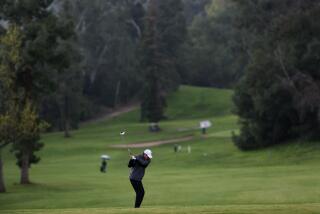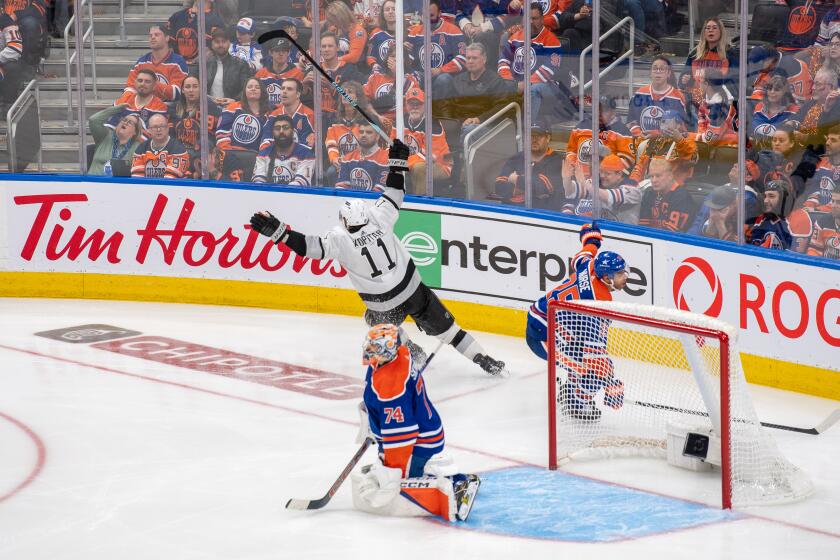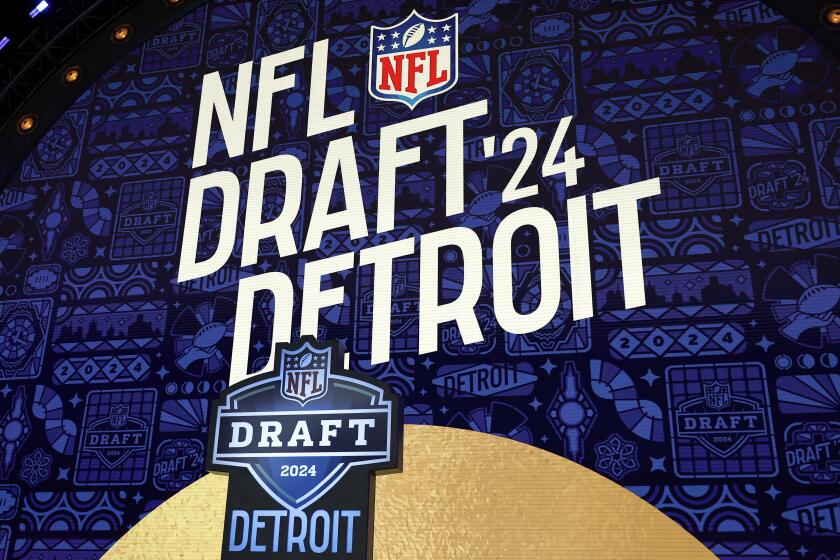Golf officials recommend ban on ‘anchored’ putting
It was the summer of 1966 and the legendary Sam Snead had come down with a case of the “yips.”
Nothing in golf is more dreadful than trembling hands that cause putts to roll astray. But when Snead found a simple cure — standing astride the ball as if playing croquet — officials quickly banned the technique.
“The history of the game cries out that you play it from one side of the ball,” Joseph Dey Jr., head of the U.S. Golf Assn., said at the time.
Golf is nothing if not protective of its traditions. The Snead rule is but one example of the sport’s rule-makers attempting to ward off change.
They have fought golf balls designed to fly straighter and clubs built to hit longer. The latest threat comes in the form of extra-long putters that golfers can anchor against their bellies or chests for stability.
On Wednesday, U.S. and British officials recommended banishing the “anchored putting” style, which was recently used by the winners of two major tournaments.
“Anchored strokes threaten to supplant traditional strokes, which with all their frailties are integral to the long-standing character of our sport,” said Peter Dawson, chief executive of the R&A;, which regulates golf for much of the world outside of the U.S. and Mexico.
The announcement has generated intense debate among those who want to see the game progress and others who believe that history is a big part of its allure.
“You’re weighing a whole lot of competing values,” said Robert Simon, a philosophy professor at Hamilton (N.Y.) College who has chronicled the game. “Maybe they’re using tradition as a tiebreaker.”
Anchored putting has been around for decades but has only recently become widely popular. The USGA and R&A; — golf’s two major governing bodies — are addressing the issue as part of a regular cycle in which they consider rule amendments every four years.
No final decision will be made until early next year. Over the next few months, officials have said they will accept comments from around the golf world.
“There’s going to be a lot of upset people,” said Steve Stricker, a PGA Tour pro competing at the World Challenge event in Thousand Oaks this week. “A lot of guys have putted with a long putter for a long time.”
They include Keegan Bradley, who won the 2011 PGA Championship, and Ernie Els, who won the 2012 British Open.
Bradley, who is also at the World Challenge, called the proposed ban “a little frustrating” but added: “I do understand the USGA is trying to protect the game.”
If approved, the new Rule 14-1b would go into effect in January 2016. A player anchoring his putter in match play would automatically lose the hole. In stroke play, he would suffer a two-stroke penalty for each occurrence.
“The player’s challenge is to control the movement of the entire club in striking the ball,” said Mike Davis, the USGA’s executive director. “And anchoring the club alters the nature of that challenge.”
Critics of the proposed change argue there is no research proving that anchored putting is advantageous. They note that previous rules have been based on empirical data.
Years ago, manufacturers discovered they could counteract hooks and slices by varying the placement of dimples on the ball’s cover. Golf’s governing bodies subsequently banned these “asymmetrical” designs.
Later, the same thing happened with high-tech, long-hitting drivers. Many golf courses initially responded by moving tee boxes back, adding more yardage to holes, but they were running out of room. So golf placed limits on club size and spring-like effect on the ball.
And when club designers cut a new style of groove into the faces of their irons, allowing players to control shots with greater spin, golf outlawed the new “square grooves” and made club manufacturers revert to the old style.
On Wednesday, officials characterized the proposed ban on “anchored putting” as a technique rule, not an equipment rule. Long putters would still be allowed as long as golfers did not anchor the clubs against their bodies.
Not everyone believed that.
“In theory, manufacturers won’t be affected,” said John Morrissett, a former USGA director of rules. “But, obviously, if you can’t anchor the belly putter against your belly, you won’t buy one.”
Simon suspects that something more than technology and tradition are at stake here. The professor talks about a paradox at the heart of the game.
While golfers yearn to shoot lower scores, most also appreciate the game’s difficulty.
“It’s something you can never quite conquer,” he said. “We don’t want to make it too easy.”
But a game with shrinking participation doesn’t want to be too hard either. The golf industry is looking for ways to keep older players coming back while attracting newcomers.
In baseball, recreational players and Little Leaguers can use aluminum bats to hit the ball farther. Golf is different. If the new rule is put in place, it will affect millions of players.
That means a 50-year-old man competing in a sanctioned local tournament cannot anchor a putter against his belly. He must follow the same rules as Tiger Woods at the Masters.
Twitter: @LATimesWharton
Times staff writer Jim Peltz contributed to this report.
More to Read
Get our high school sports newsletter
Prep Rally is devoted to the SoCal high school sports experience, bringing you scores, stories and a behind-the-scenes look at what makes prep sports so popular.
You may occasionally receive promotional content from the Los Angeles Times.





